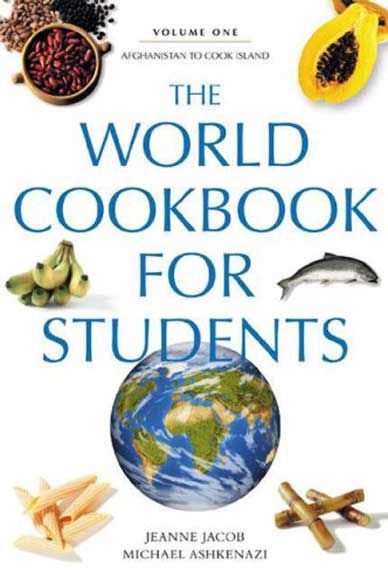
This set aims “to introduce readers, in particular U.S. students, to contemporary foodstuffs, ways of eating, and typical cookery in almost every country in the world.” It includes 198 alphabetically listed nation-states and “nationalities without states.” Each one is shown on a map, and its history, geography, and ethnic or religious makeup is briefly introduced. An average of five or six recipes is provided per entry, with exceptions for the largest and smallest nations. When a recipe includes ingredients not available in the U.S., substitutions are suggested.
A secondary objective is to allow students to compare dishes, such as yogurt, rice, and pasta, which are common in various countries. Sidebars offering information on topics like the African staple manioc porridge, and pen-and-ink illustrations of unusual foodstuffs, dot the text. Each volume has its own table of contents. The first volume includes lists of countries and regions and recipes by region and a brief glossary. A comprehensive set index concludes each volume. While the dishes are not especially complicated to make, they do assume familiarity with basic cooking techniques. The only safety advisory pertains to handling fresh chili peppers. However, the choices are appropriate and are accurately described, and the background material is reliable. This is a useful resource for multidisciplinary studies involving the social sciences, language arts, and consumer education, as well as general interest. Bon appetit!
We’ve all had the assignment: make a dish from another country and bring it to school for the cultural potluck. The recipes in The World Cookbook for Students now make that assignment a piece of cake! In five volumes, hundreds of recipes representing nearly 200 countries and regions of the world can be found. Moreover, the authors go beyond listing recipes and offer students a glimpse of different ways of eating and preparing foods. Arranged alphabetically, each country entry contains brief historical and geographic comments, lists of typical foods and dishes served, and a description of how and when foods are eaten. For example, the entry for Benin lists foodstuffs like goat, sorghum, gnembue (a vegetable), mangoes, and wangash (a tofulike cheese) and dishes such as akassa (cornmeal wrapped in leaves) and ago glain (a special-occasion stew). The recipes in each entry typically include an appetizer, soup, main dish, dessert, and festival dish. At least one vegetarian dish is in each entry as well. Although five recipes are the norm, more are provided for the five “great cuisines” of the world. Each recipe includes when the dish is typically served, a list of ingredients in U.S. standard measurements, and directions. The recipes are designed for four people based on one-half pound of meat and vegetables per person. As for the U.S. recipes, pancakes, relish, meatloaf, fried chicken, ice cream, and brownies are represented. Unfortunately, there are no photos or other visual guides to assist students with the preparation or to demonstrate the final product. This is disappointing considering the number of unusual ingredients and dishes included in the set. Several black-and-white sketches, found throughout the volumes, illustrate a food item or utensil. Volumes begin with a list of countries and the included recipes, but recipe names are not indexed nor are some key terms—rice, for example. Although volume 5 contains an extensive bibliography, including numerous Web sites, the glossary is paltry, defining only 12 terms. Overall, the recipes and background information on countries are informative and creative, but the set lacks a much-needed visual component combined with a strong index and glossary. For public and school libraries.
.
http://www.rarefile.net/hz50wulhqp7c/WCookbookStudents.rar
.

















2 Responses to this entry.
Thanks, MaxD and team! 🙂
Thanks Max